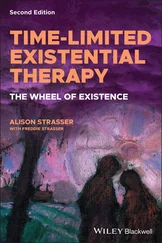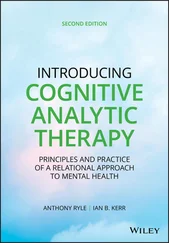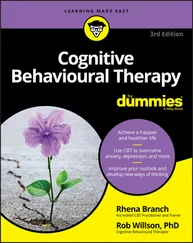Avy Joseph - Cognitive Behaviour Therapy
Здесь есть возможность читать онлайн «Avy Joseph - Cognitive Behaviour Therapy» — ознакомительный отрывок электронной книги совершенно бесплатно, а после прочтения отрывка купить полную версию. В некоторых случаях можно слушать аудио, скачать через торрент в формате fb2 и присутствует краткое содержание. Жанр: unrecognised, на английском языке. Описание произведения, (предисловие) а так же отзывы посетителей доступны на портале библиотеки ЛибКат.
- Название:Cognitive Behaviour Therapy
- Автор:
- Жанр:
- Год:неизвестен
- ISBN:нет данных
- Рейтинг книги:5 / 5. Голосов: 1
-
Избранное:Добавить в избранное
- Отзывы:
-
Ваша оценка:
- 100
- 1
- 2
- 3
- 4
- 5
Cognitive Behaviour Therapy: краткое содержание, описание и аннотация
Предлагаем к чтению аннотацию, описание, краткое содержание или предисловие (зависит от того, что написал сам автор книги «Cognitive Behaviour Therapy»). Если вы не нашли необходимую информацию о книге — напишите в комментариях, мы постараемся отыскать её.
Cognitive Behaviour Therapy
Cognitive Behaviour Therapy
Cognitive Behaviour Therapy — читать онлайн ознакомительный отрывок
Ниже представлен текст книги, разбитый по страницам. Система сохранения места последней прочитанной страницы, позволяет с удобством читать онлайн бесплатно книгу «Cognitive Behaviour Therapy», без необходимости каждый раз заново искать на чём Вы остановились. Поставьте закладку, и сможете в любой момент перейти на страницу, на которой закончили чтение.
Интервал:
Закладка:
Believing that the past, or a particular situation or person, causes our feelings today, means that no one would ever be able to move forward or to change. We would all be totally stuck without any possibility or hope of ever changing anything. We would be slaves to the things that had happened to us or the people we had been involved with.
Can you imagine what it would be like if everyone felt hurt every time they experienced a rejection of some sort?
Rejection = Hurt
10 people rejected = 10 people feeling hurt
100 people rejected = 100 people feeling hurt
1000 people rejected = 1000 people feeling hurt
As an example, when you experience rejection you might feel hurt. However, if you believe that your feelings are caused by others, you may then believe that being rejected by someone is the cause of your hurt feelings. But don't some of us experience different emotions if rejected by someone we like? Maybe anger, sadness, depression or relief?
In fact, different people may feel different emotions when they experience the same event:
Some people feel hurt.
Some people feel angry.
Some people feel depressed.
Some people couldn't care less.
Why do different people feel different things and what is at the heart of their feelings?
Is it true that events or people make us do what we do?
Let's think about what we do and assume that situations or people make us behave as we do.
A colleague criticizes you = You start avoiding them
If it is true that a colleague's criticism ‘made’ you avoid them, this means that every criticism made by your colleague would have the same effect on everyone. It means that avoidance is the only possibility whenever your colleague criticizes you, or anyone else for that matter.
A colleague criticizes 10 people = 10 people avoid them
A colleague criticizes 100 people = 100 people avoid them
A colleague criticizes 1000 people = 1000 people avoid them
Does this make sense?
The problem is that people say, ‘he made me do it’ or ‘she made me lose my temper’. It is as if they have absolutely no control over their behaviour. Once again, if we do not have a part to play in how we behave, then we would be completely stuck, unable to move forward, learn or do anything useful. Is this what you see happening to everyone around you?
So what provokes your feelings and behaviour? Most of the time the simple answer is that you do. You provoke your feelings and actions by the way you think, the attitudes you've formed, the habits you no longer question and the beliefs you hold.
This is the principle of Emotional Responsibility: You are largely responsible for the way you feel and act.
The principle of emotional responsibility can be challenging, particularly if you are going through a difficult time or have experienced trauma or personal tragedy. It's natural to feel angry, sad, depressed or hurt in response to accidents, illness and other challenges in life, but if you get stuck in these feelings then you can change them.
The thought manifests as the word; The word manifests as the deed; The deed develops into habit;
And habit hardens into character;
So watch the thought and its ways with care. (Buddha)
The way you think about something affects how you feel and how you behave. Here are some examples:
If you think that your partner's late arrival for dinner proves that you are not lovable then you might feel hurt and sulk.
If you think that your partner was nasty and selfish because they arrived late for dinner then you might feel angry and shout.
If you think that your partner's late arrival for dinner is no big deal then you can feel calm about it and ask what happened.
This shows that it is not the situation or what happens to us that provokes our feelings and behaviour. It is the way we think about the situation. The way we think about something can then influence how we behave.
THE BEHAVIOURAL PRINCIPLE
CBT considers behaviour as significant in maintaining or in changing psychological states. If, for example, you avoid some event such as giving a presentation to your team, then you will deny yourself the opportunity to disconfirm your negative thoughts about yourself or capabilities. Furthermore, avoidance only sabotages what you want to achieve. Changing what you do is often a powerful way of helping you change thoughts and emotions and ultimately what you can achieve.
THE ‘HERE AND NOW’ PRINCIPLE
Traditional therapies take the view that looking at problems in the here and now is superficial. They consider successful treatment must uncover the childhood developmental issues, hidden motivations and unconscious conflicts that are supposed to lie at the root of the problem. These approaches argue that treating the current problem rather than the supposed hidden ‘root’ causes would result in symptom substitution, that is, the problem would re‐surface in another form later on. There is little evidence to support this idea. Behaviour therapy also showed that such an outcome, although possible, was very rare.
CBT offers theories about how current problems are being maintained and kept alive and how they can be changed.
THE SCIENTIFIC PRINCIPLE
CBT offers scientific theories. Scientific theories are designed in a way so they can be tested. CBT has been evaluated rigorously using evidence rather than just clinical anecdote. This is important for a couple of reasons:
The treatment can be founded on sound and well‐established theories.
Ethically, CBT therapists can have confidence in the therapy they are advocating.
Exercise
List five things that people manage to change about themselves despite doing it badly at first (for example, learning to drive).
1.
2.
3.
4.
5.
List five positive things that you have learned in your life despite experiencing difficulties (for example, moving on from a failed relationship).
1.
2.
3.
4.
5.
Think of an inspirational person who has overcome enormous obstacles by having a powerful and constructive attitude and positive behaviour.
Truth
In CBT we examine our thoughts and behaviours to check if they are realistic. This means we judge and evaluate an event based on facts rather than perception, which can be flawed. Why do you think that, when an accident occurs, the police take statements from a number of people instead of asking just one person what happened?
Truth is about being consistent with reality whilst striving for the goals that are important to you. It's about acknowledging and accepting the existence of the possibilities you dislike while persisting in your efforts to reach your goals.
Exercise
How many ‘F's can you count in the following statement?
FINISHED FILES ARE THE RESULTS OF YEARS OF SCIENTIFIC STUDY COMBINED WITH THE EXPERIENCE OF MANY YEARS.
Did you see 2 or 3 ‘F's?
There are 6.
I will leave you to find the rest but simply draw your attention to the word ‘of’.
The above is a popular example used to highlight the fact that we don't necessarily see the whole truth. We interpret what we see and experience. What you have learnt from this simple but effective exercise is that your version of the truth can be faulty. It is important to question the truth that you hold about yourself and your ability just in case you are seeing only a few of the good things and missing many others. Sometimes we only see a few ‘F's, when in reality there are more. If the ‘F's represent your positive abilities and qualities, how many of the good qualities are you seeing?
Читать дальшеИнтервал:
Закладка:
Похожие книги на «Cognitive Behaviour Therapy»
Представляем Вашему вниманию похожие книги на «Cognitive Behaviour Therapy» списком для выбора. Мы отобрали схожую по названию и смыслу литературу в надежде предоставить читателям больше вариантов отыскать новые, интересные, ещё непрочитанные произведения.
Обсуждение, отзывы о книге «Cognitive Behaviour Therapy» и просто собственные мнения читателей. Оставьте ваши комментарии, напишите, что Вы думаете о произведении, его смысле или главных героях. Укажите что конкретно понравилось, а что нет, и почему Вы так считаете.












